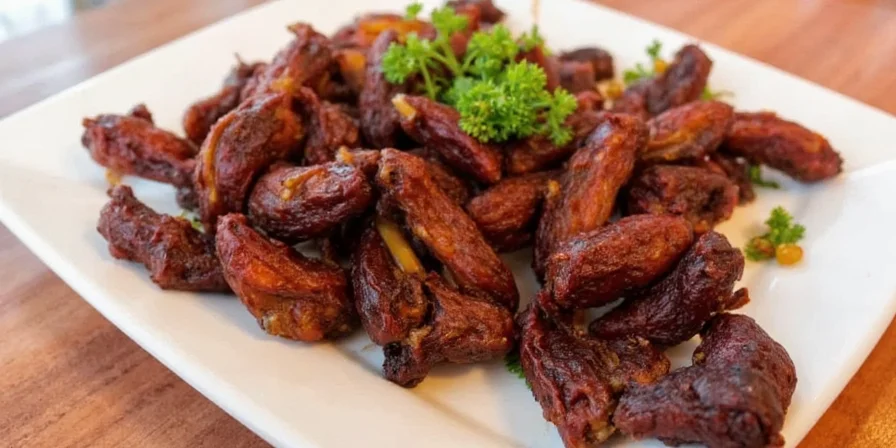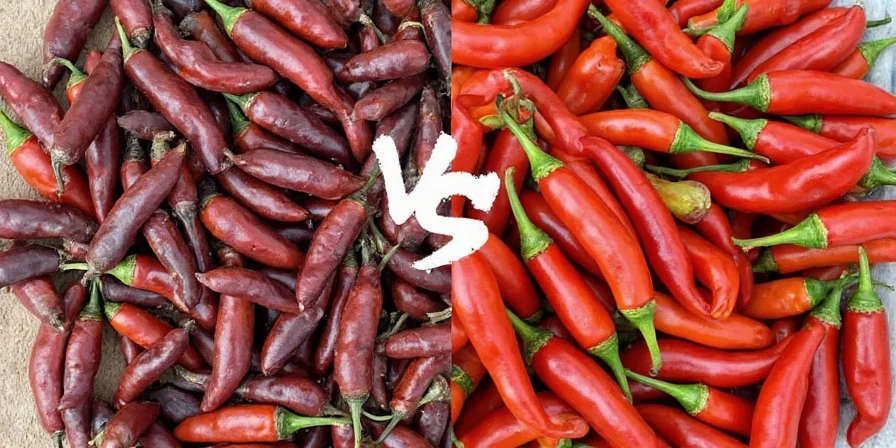Guajillo chiles (2,500-5,000 SHU) are significantly hotter than Pasilla chiles (1,000-2,500 SHU), with Guajillo offering bright berry-citrus notes while Pasilla provides deep earthy-raisin flavors. For authentic Mexican cooking, use Guajillo in red sauces and salsas, and Pasilla in complex moles and slow-cooked dishes. This 2025 comparison details exact heat levels, flavor profiles, substitution ratios, and professional chef techniques to maximize their unique characteristics.
Guajillo vs Pasilla: Heat, Flavor, and Best Uses at a Glance
| Characteristic | Guajillo | Pasilla |
|---|---|---|
| Heat Level (SHU) | 2,500-5,000 (Medium) | 1,000-2,500 (Mild) |
| Flavor Profile | Tangy berry, citrus, subtle smoke | Raisin, tobacco, earthy depth |
| Color When Rehydrated | Bright brick red | Deep mahogany brown |
| Primary Culinary Applications | Red enchilada sauce, salsas, marinades | Mole negro, stews, braises |
| Best Substitute | Ancho (milder), New Mexico (similar heat) | Mulato (closest match), Anaheim (milder) |





Exact Heat Comparison: Which Chile Packs More Punch?
Guajillo consistently measures hotter than Pasilla on the Scoville scale, with Guajillo ranging from 2,500-5,000 SHU compared to Pasilla's 1,000-2,500 SHU. This difference becomes especially noticeable in sauces where concentration occurs. When substituting between them, use a 1:1.5 ratio (1 Pasilla = 1.5 Guajillo) to maintain balanced heat. Professional kitchens always remove seeds from Guajillo when creating family-friendly dishes, while Pasilla's milder heat often allows whole usage.
Flavor Profiles Decoded: Beyond Just Heat
Guajillo: The Bright Flavor Enhancer
Guajillo delivers a complex flavor profile featuring prominent notes of:
• Tart dried cranberry
• Sun-ripened tomato
• Citrus zest (particularly orange)
• Subtle wood smoke
This bright acidity makes Guajillo ideal for dishes needing flavor lift. When properly toasted (30 seconds per side in dry skillet), its natural sugars caramelize, enhancing the fruit-forward character without increasing heat.
Pasilla: The Depth Creator
Pasilla offers a fundamentally different flavor spectrum characterized by:
• Dark raisin and prune
• Leather and tobacco undertones
• Earthy mushroom notes
• Mild coffee bitterness
Unlike Guajillo, Pasilla benefits from longer rehydration (30 minutes in 180°F water) which extracts its complex earthiness without bitterness. The deepest flavor develops when blended with a small amount of the soaking liquid.
Professional Chef Applications: Where Each Excels
Guajillo's Prime Uses
- Authentic Red Enchilada Sauce: Forms the base for Mexico City-style sauces, providing vibrant color and balanced heat that doesn't overpower fillings
- Poultry Marinades: Its acidic profile tenderizes while adding flavor (use 3 rehydrated chiles per pound of chicken)
- Fresh Salsas: Blended with tomatoes and tomatillos for restaurant-quality table salsa
Pasilla's Signature Dishes
- Mole Negro: Contributes 40% of the foundational flavor in Oaxacan mole (use 6 Pasilla per 2 cups sauce)
- Slow-Cooked Meats: Adds background warmth to carnitas and birria without dominating other spices
- Vegetable Stocks: Imparts rich color and depth to vegetarian bases (1 chile per gallon)
Precise Substitution Guidelines
When ingredient substitutions become necessary, follow these chef-tested ratios for authentic results:
- Replacing Guajillo: Use 1 Ancho + ¼ teaspoon cumin per Guajillo for similar depth with less heat, or 1 New Mexico chile for closest heat match
- Replacing Pasilla: Combine ¾ Mulato + ¼ Ancho for identical flavor complexity, or use Anaheim with 1 teaspoon cocoa powder for mole applications
- Critical Tip: Always adjust liquid content when substituting—Guajillo requires 20% less soaking liquid than Pasilla due to denser flesh
Professional Handling Techniques
- Targeted Toasting: Heat Guajillo just until fragrant (30 seconds) to preserve fruitiness; toast Pasilla 45-60 seconds to develop earthy notes
- Seed Management: Remove Guajillo seeds for mild applications but keep Pasilla seeds for maximum flavor extraction
- Rehydration Science: Use 180°F water (not boiling) to prevent bitterness—1 cup water per 5 chiles
- Blending Protocol: Blend Guajillo with soaking liquid first, then strain; blend Pasilla with liquid and immediately use for best results
- Storage Data: Properly stored (airtight, dark, cool), Guajillo maintains peak quality 8 months, Pasilla 10 months
Debunking Common Misconceptions
- "Pasilla is just dried Poblano": Incorrect—Pasilla comes from dried Chilaca peppers, while Poblano becomes Ancho when dried
- "Guajillo always tastes hotter": Varies by harvest—test new batches by making small sauce samples before full recipes
- "They're interchangeable in moles": Professional moles use specific ratios—substituting changes the flavor architecture
Advanced Flavor Layering Technique
For restaurant-quality depth in home cooking, combine both chiles using the chef-recommended 3:2 ratio (Pasilla:Guajillo). Start by rehydrating 3 Pasilla and 2 Guajillo in separate batches. Blend Pasilla first with its soaking liquid to create the flavor foundation, then fold in Guajillo puree. This creates a flavor arc that begins with Pasilla's earthiness and finishes with Guajillo's bright notes—mimicking traditional 7-chile moles using just two ingredients. This technique works exceptionally well for weeknight mole poblano with only 25 minutes preparation.
Which Should You Choose for Your Next Dish?
Select Guajillo when you need:
• Bright acidity in tomato-based sauces
• Medium heat that complements (not dominates) other ingredients
• Vibrant red color for visual appeal
Choose Pasilla when you need:
• Deep, complex background notes
• Mild heat for family-friendly dishes
• Earthy richness in slow-cooked preparations
For authentic Mexican cooking, maintaining both in your pantry allows professional-level control over flavor development. Properly stored, they remain viable for 8-10 months, making them cost-effective pantry staples.
Guajillo vs Pasilla: Expert FAQ
Which chile creates a smoother sauce texture?
Pasilla produces noticeably smoother sauces due to its thinner skin and lower fiber content. Guajillo requires double-straining through a fine-mesh sieve for professional results. When time-constrained, blend Guajillo with 1 tablespoon masa harina per chile to improve texture without altering flavor.
How to fix bitter Guajillo sauce?
Bitterness in Guajillo sauce comes from over-toasting or boiling instead of simmering. Immediately add 1 teaspoon of honey and 2 tablespoons of tomato paste per cup of sauce, then simmer gently for 10 minutes. For prevention: toast no longer than 30 seconds per side and always simmer rehydrated chiles rather than boiling.
Can I use canned versions for authentic results?
Canned chipotle (smoked jalapeño) is sometimes mislabeled as Guajillo in stores. True Guajillo and Pasilla are only available dried. If using canned chiles as substitutes, increase other spices by 25% to compensate for the vinegar content which alters flavor development.
What's the most common substitution mistake?
Using equal amounts when substituting is the #1 error. Pasilla requires 25% more by weight than Guajillo to achieve similar flavor impact. When converting recipes, use 1.25 oz Pasilla for every 1 oz Guajillo called for to maintain proper flavor balance without increasing heat.











 浙公网安备
33010002000092号
浙公网安备
33010002000092号 浙B2-20120091-4
浙B2-20120091-4